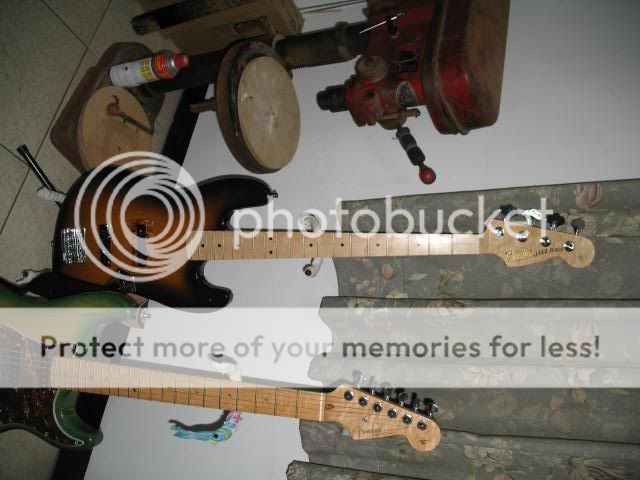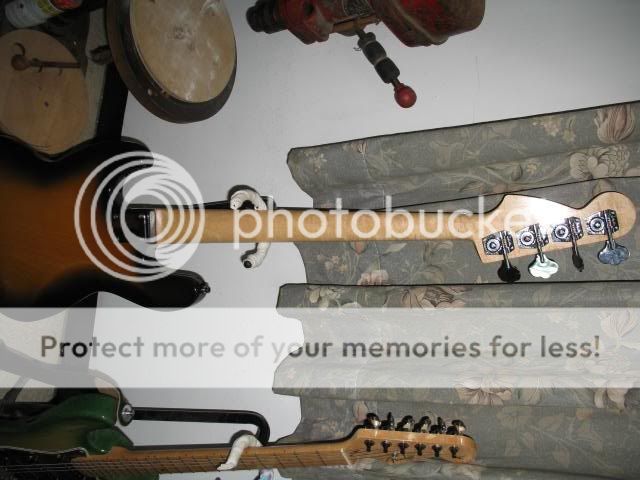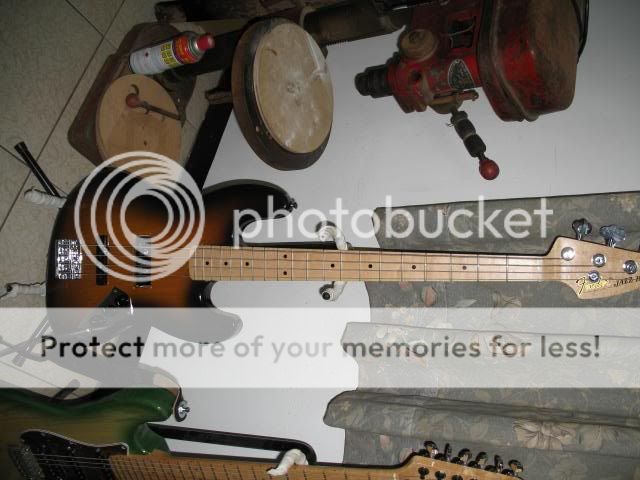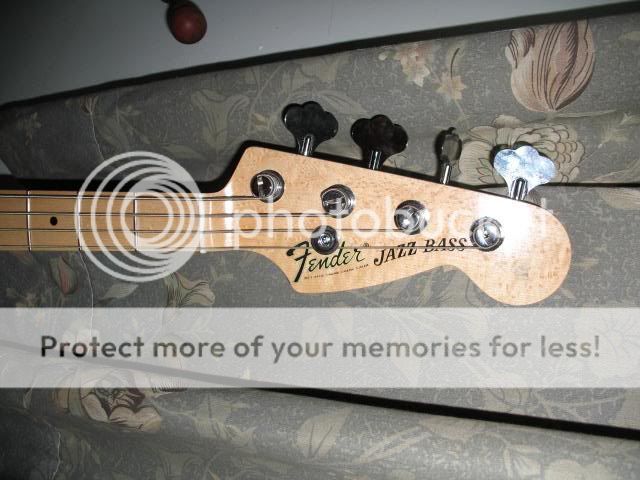Well I call this thai stick because this neck took a trip to Thailand by accident.
The body is 3 piece swamp ash mighty mite body. I got it unfinished which is a good thing because finished mighty mite body tends to have really thick poly paint on it... they're quite nice given the price too. Only bad thing is no bridge or ground wire routes so you need to do it yourself. It's not hard, just measure the right scale length and check the alignment (you can use strings for this) before you drill anything. To drill the ground wire hole you need an aircraft drill bit.





The color looks slightly lighter than it really is. The center is Stewmac Vintage Amber dye, they really have the right yellow for sunbursts. I originally intended to do a tobacco sunburst but I got carried away and ended up making the edge black with a brown mix that's too dark. I think colortone dyes are superior because their mix tends to stay the same after having lacquer sprayed over it (LMI dyes tends to become lighter which is why I made a strong mix) but they're so expensive... anyways the result still looks good just not what I had in mind....
The neck looks beautiful. I ordered a plain maple neck and I got a figured neck like I did last time. The wait was really frustrating but the final product was worth it, and Warmoth customer service is great as always.
I had to do the nut twice. First time I messed up because I eye balled the string spacing which turns out to be uneven. I was going to fill with superglue and correct that area but I decided might as well start over. I developed a more systematic way of getting the nut spacing right:
First you lay out the 2 outter most string, I would leave a spacing of about 1/8 inch from the edge of the fretboard. Place those strings there (you can cut shallow groove in the nut to keep them there). Now measure from the inside edge of the string (a dial caliper helps here, but I used a ruler) the space between the two strings. Now subtract the total diameter of the remaining strings (not including the two outter most string) from that measurement, and divide by the number of spaces you have in the nut (for a 4 string bass it's 3, for a guitar it's 5) and you have the equal spacing between strings. Now you use the spacing by measuring from the inside edge of the string and place the edge of the next string there, then mark out a space for the string then start measuring again from the inside edge of that string, and so on... A little tedious but no one makes a bass nut spacing calculator (all the ones I have seen are for guitars) and I don't want to spend $20 on a special ruler from Stewmac...
Perhaps someone who is good with programming can make a calculator that can be printed out?
The body is 3 piece swamp ash mighty mite body. I got it unfinished which is a good thing because finished mighty mite body tends to have really thick poly paint on it... they're quite nice given the price too. Only bad thing is no bridge or ground wire routes so you need to do it yourself. It's not hard, just measure the right scale length and check the alignment (you can use strings for this) before you drill anything. To drill the ground wire hole you need an aircraft drill bit.





The color looks slightly lighter than it really is. The center is Stewmac Vintage Amber dye, they really have the right yellow for sunbursts. I originally intended to do a tobacco sunburst but I got carried away and ended up making the edge black with a brown mix that's too dark. I think colortone dyes are superior because their mix tends to stay the same after having lacquer sprayed over it (LMI dyes tends to become lighter which is why I made a strong mix) but they're so expensive... anyways the result still looks good just not what I had in mind....
The neck looks beautiful. I ordered a plain maple neck and I got a figured neck like I did last time. The wait was really frustrating but the final product was worth it, and Warmoth customer service is great as always.
I had to do the nut twice. First time I messed up because I eye balled the string spacing which turns out to be uneven. I was going to fill with superglue and correct that area but I decided might as well start over. I developed a more systematic way of getting the nut spacing right:
First you lay out the 2 outter most string, I would leave a spacing of about 1/8 inch from the edge of the fretboard. Place those strings there (you can cut shallow groove in the nut to keep them there). Now measure from the inside edge of the string (a dial caliper helps here, but I used a ruler) the space between the two strings. Now subtract the total diameter of the remaining strings (not including the two outter most string) from that measurement, and divide by the number of spaces you have in the nut (for a 4 string bass it's 3, for a guitar it's 5) and you have the equal spacing between strings. Now you use the spacing by measuring from the inside edge of the string and place the edge of the next string there, then mark out a space for the string then start measuring again from the inside edge of that string, and so on... A little tedious but no one makes a bass nut spacing calculator (all the ones I have seen are for guitars) and I don't want to spend $20 on a special ruler from Stewmac...
Perhaps someone who is good with programming can make a calculator that can be printed out?



